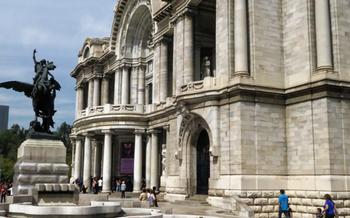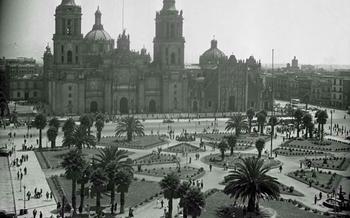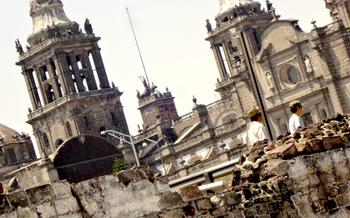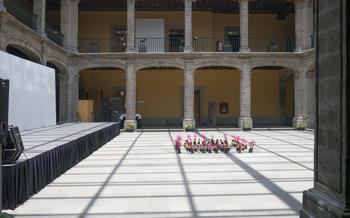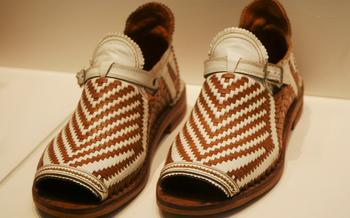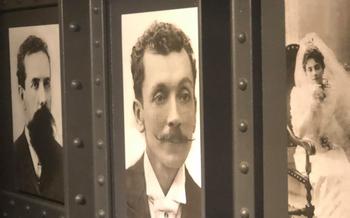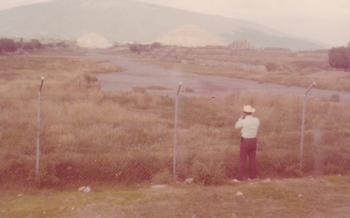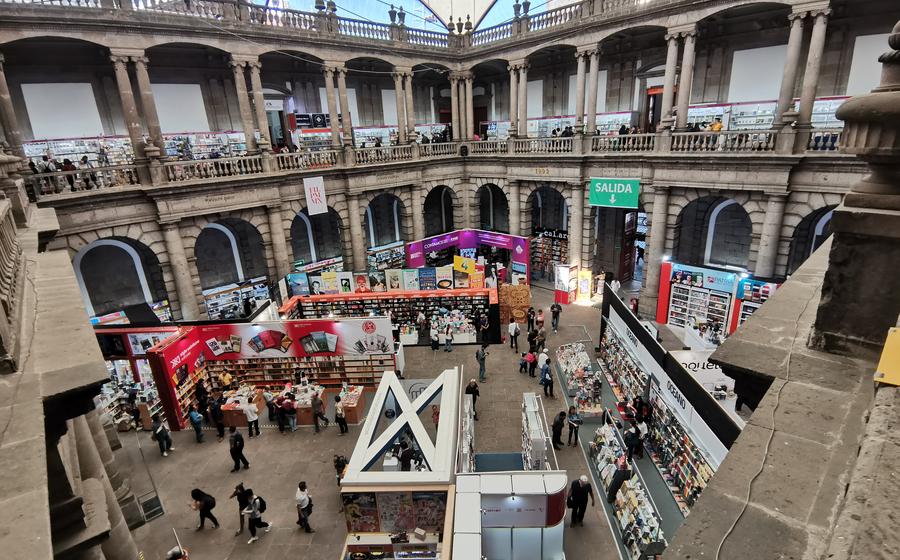
Palacio de Minería
- Exploring the Grand Courtyard: A Majestic Space
- Marveling at the Main Staircase: A Masterpiece of Design
- Unveiling the Mining Museum: A Journey into Mexico's Mining History
- Discovering the National Numismatic Museum: A Treasure Trove of Coins
- Admiring the Diego Rivera Murals: A Cultural Legacy
- Attending Events and Exhibitions: A Vibrant Cultural Hub
- Taking Advantage of Guided Tours: An Immersive Experience
- Exploring the Surrounding Area: Hidden Gems and Culinary Delights
- Planning Your Visit: Essential Information
- Capturing Memorable Moments: Photography and Videography
- Respecting the Building's Heritage: A Cultural Landmark
- Engaging with the Local Community: Cultural Exchange
- Exploring Beyond Mexico City: Neighboring Gems
- Insider Tip: Discovering Hidden Corners
Exploring the Grand Courtyard: A Majestic Space
The grand courtyard of the Palacio de Minería is a sight to behold, with its expansive dimensions and elegant design. As you step inside, you'll be greeted by a sprawling open space surrounded by majestic arches, towering columns, and intricate sculptures. The courtyard's harmonious blend of architectural elements creates a sense of awe and grandeur.
Notable features of the courtyard include the series of arches that line the perimeter, supported by sturdy columns. These arches add depth and dimension to the space, creating a captivating interplay of light and shadow. The sculptures that adorn the courtyard depict various figures and scenes, adding a touch of artistic flair and historical significance.
The courtyard serves as a popular venue for a variety of events, concerts, and exhibitions. Its spacious layout and versatile design make it an ideal setting for grand gatherings and cultural performances. Whether you're attending a book fair, an art show, or a musical concert, the courtyard provides a memorable backdrop for any occasion.
Accessibility is a key consideration at the Palacio de Minería, and the courtyard is no exception. Wheelchair ramps and elevators ensure that visitors with disabilities can navigate the space with ease. This commitment to inclusivity allows everyone to fully experience the beauty and grandeur of this historic building.
Marveling at the Main Staircase: A Masterpiece of Design
As you step inside the Palacio de Minería, your gaze is immediately drawn to the grand staircase, a true masterpiece of architectural design. Its sweeping curves and intricate details create a sense of awe and opulence. The staircase is constructed from gleaming marble and bronze, materials that exude elegance and durability. Each step is adorned with intricate carvings and sculptures, showcasing the exceptional craftsmanship of the building's creators.
The staircase is not merely a functional element but a symbol of the building's grandeur. Its imposing presence conveys a sense of power and authority, reflecting the importance of the mining industry in Mexico's history. The staircase serves as a reminder of the wealth and influence that the mining industry brought to the country.
To fully appreciate the staircase's beauty, take a moment to ascend its steps. As you climb, admire the intricate details of the banisters, the delicate scrollwork, and the lifelike sculptures that adorn the walls. The play of light and shadow on the staircase's surfaces creates a mesmerizing effect, making it a popular spot for photography enthusiasts.
For the perfect photo opportunity, position yourself at the base of the staircase and capture its full grandeur. Experiment with different angles and lighting conditions to create a truly stunning image. Remember to be mindful of other visitors and avoid blocking their path while taking photos.
Unveiling the Mining Museum: A Journey into Mexico's Mining History
Within the grand walls of the Palacio de Minería, visitors can embark on a fascinating journey into the depths of Mexico's mining history at the Mining Museum. This esteemed institution houses an extensive collection of artifacts, documents, and exhibits that shed light on the country's rich mining heritage, which has played a pivotal role in shaping its economy and culture.
The museum's displays offer a comprehensive exploration of mining techniques, equipment, and processes employed throughout the centuries. Visitors can marvel at an array of minerals, ores, and gemstones, gaining insights into their geological origins and industrial significance. Interactive exhibits bring the history of mining to life, allowing visitors to engage with the challenges and triumphs of this demanding field.
Guided tours are available to enhance the museum experience, providing expert commentary and anecdotes that bring the exhibits to life. These tours offer an in-depth exploration of the museum's collection, uncovering the stories behind the artifacts and highlighting the contributions of notable figures in Mexican mining history.
Insider Tip: Before your visit, check the museum's website or inquire at the information desk about any special programs or workshops they may offer. These events provide an opportunity to delve deeper into specific aspects of mining history or participate in hands-on activities that make learning even more engaging.
Discovering the National Numismatic Museum: A Treasure Trove of Coins
Step into the National Numismatic Museum, a hidden gem within the Palacio de Minería, and embark on a journey through the fascinating world of coins. This museum houses an awe-inspiring collection of coins, banknotes, and medals, offering a glimpse into the rich history of Mexican currency.
The exhibits take you on a chronological journey, showcasing the evolution of Mexican currency from pre-Columbian times to the present day. Marvel at ancient coins adorned with intricate symbols and images, representing the diverse cultures that have shaped Mexico's history. Trace the development of modern coinage, from the introduction of the peso in the 19th century to the colorful and commemorative coins of today.
Temporary exhibitions add an element of freshness to the museum's offerings, featuring unique numismatic artifacts from around the world. These exhibits might showcase rare coins from ancient civilizations, commemorative medals celebrating historical events, or even contemporary art installations that incorporate coins as a medium.
Insider tip: The National Numismatic Museum offers educational programs for children, providing a fun and interactive way to learn about the history of money. Check the museum's website or inquire at the information desk for more details on these programs.
Admiring the Diego Rivera Murals: A Cultural Legacy
The Rivera. These captivating artworks, created in the 1930s, stand as a testament to Rivera's artistic genius and his profound love for his homeland. Through his murals, Rivera narrates the rich history, culture, and industrial heritage of Mexico, using vibrant colors, intricate details, and symbolic imagery.
One of the most striking murals is titled "The History of Mining in Mexico," which depicts the evolution of mining from pre-Hispanic times to the modern era. Rivera's portrayal of miners and their struggles highlights the significance of this industry in shaping Mexico's economic and social development. Another notable mural, "The Allegory of Science," celebrates the contributions of science and technology to human progress.
Rivera's murals are not merely decorative elements; they are powerful tools of storytelling that educate and inspire viewers. His skillful use of allegory and symbolism invites visitors to contemplate the complexities of Mexican identity, the struggles of the working class, and the resilience of the Mexican spirit.
To fully appreciate the depth and significance of Rivera's murals, guided tours are highly recommended. These tours provide valuable insights into the artist's techniques, his sources of inspiration, and the historical context of his work. Whether you're an art enthusiast, a history buff, or simply someone who appreciates beauty, the Diego Rivera murals at the Palacio de Minería are an absolute must-see.
Attending Events and Exhibitions: A Vibrant Cultural Hub
The Palacio de Minería has established itself as a prominent venue for hosting prestigious events, exhibitions, and cultural gatherings. Throughout the year, the building's grand halls and galleries come alive with a diverse range of events that cater to various interests.
Regular exhibitions showcasing contemporary art, history, and science take center stage, attracting art enthusiasts, scholars, and curious minds alike. These exhibitions provide a platform for emerging and established artists to showcase their work, while delving into historical narratives and scientific advancements.
The Palacio de Minería's reputation extends beyond its permanent exhibitions, as it plays host to annual events that draw national and international attention. The International Book Fair, a literary extravaganza, transforms the building into a hub of bibliophiles, where book lovers can browse an extensive collection of works, meet authors, and attend literary discussions.
The Mining Fair, a nod to the building's mining heritage, brings together industry experts, enthusiasts, and businesses to celebrate the rich history of Mexican mining. Through interactive displays, seminars, and exhibitions, visitors gain insights into the evolution of mining techniques, the significance of minerals, and the industry's impact on society.
To fully immerse yourself in the cultural offerings of the Palacio de Minería, it is advisable to check the event schedule in advance. This will ensure that you don't miss any of the captivating exhibitions, conferences, or performances that grace its halls. Booking tickets online or through the official website is recommended to avoid any disappointment.
Taking Advantage of Guided Tours: An Immersive Experience
Embarking on a guided tour of the Palacio de Minería is an enriching experience that enhances your understanding of this architectural masterpiece. Knowledgeable guides provide insightful commentary on the building's history, architecture, and cultural significance, bringing the Palacio's stories to life.
Various tour options are available, catering to different interests and preferences. General admission tours offer a comprehensive overview of the building's highlights, including the grand courtyard, the main staircase, and the Diego Rivera murals. Thematic tours delve deeper into specific aspects, such as the history of mining in Mexico or the artistic techniques employed by Rivera.
For an exclusive experience, consider booking a private tour. These tours allow you to customize your itinerary based on your interests and explore areas that are typically restricted to the public. Whether you're an architecture enthusiast, a history buff, or simply seeking a deeper connection to the Palacio de Minería's legacy, guided tours offer an immersive journey into the heart of this cultural icon.
Insider tip: Consider booking a tour that includes access to restricted areas, such as the rooftop terrace or the Mining Museum's vault, for an unforgettable behind-the-scenes experience.
Exploring the Surrounding Area: Hidden Gems and Culinary Delights
Beyond the walls of the Palacio de Minería, the surrounding area is a treasure trove of cultural and culinary delights. Take a short stroll and discover historic churches like the Templo Mayor, a testament to Mexico's pre-Columbian heritage. Marvel at the grandeur of the Palacio de Bellas Artes, an iconic opera house and museum showcasing Mexican and international art. For a glimpse into the city's vibrant theater scene, visit the Teatro de la Ciudad Esperanza Iris, a beautiful Art Deco venue hosting a variety of performances.
Indulge in the flavors of traditional Mexican cuisine at nearby restaurants. Savor the authentic taste of tacos al pastor at El Huequito, a local favorite known for its succulent spit-roasted pork tacos. For a unique culinary experience, try the pre-Hispanic dishes at Restaurante El Cardenal, a century-old establishment serving up ancient recipes with a modern twist. Don't miss the chance to sip on a refreshing michelada, a beer-based cocktail, at one of the many bars and cafes lining the streets.
Unearth hidden gems like the Plaza Garibaldi, just a short walk away. This lively square is renowned for its mariachi bands, filling the air with their enchanting melodies. Enjoy a serenade while sipping on a glass of tequila, embracing the vibrant spirit of Mexico. Whether you're seeking cultural immersion or culinary adventures, the surroundings of the Palacio de Minería offer an abundance of experiences, waiting to be discovered.
Planning Your Visit: Essential Information
Before embarking on your exploration of the Palacio de Minería, it's essential to plan your visit effectively. The building is typically open to the public from Tuesday to Sunday, with varying hours on weekdays and weekends. Check the official website or contact information provided for the exact operating hours to avoid any inconvenience. Ticket prices vary depending on the type of visit, with general admission tickets offering access to the main areas of the building. Consider purchasing a combined ticket that includes entry to the Mining Museum and the National Numismatic Museum for a more comprehensive experience. Guided tours are available in various languages, providing in-depth insights into the history and significance of the Palacio de Minería. These tours are highly recommended, especially for first-time visitors. To ensure a smooth and enjoyable visit, consider these practical tips: arrive early to avoid crowds, wear comfortable shoes as you'll be doing a lot of walking, and bring a camera to capture the building's stunning architecture and exhibits. Remember to be respectful of the building's heritage and follow any guidelines or restrictions in place to preserve its cultural value.
Capturing Memorable Moments: Photography and Videography
The Palacio de Minería's architectural grandeur and cultural significance make it a photographer's paradise. Whether you're a professional or an enthusiast, capturing the essence of this iconic building is a must.
Inside the Palacio, photography and videography are generally permitted, but there are a few guidelines to keep in mind. Using tripods and flash photography is allowed, but be mindful of other visitors and avoid blocking their views. Respect the privacy of others, and ask permission before taking photos or videos of individuals. If you're unsure about any restrictions, consult with the on-site staff.
When it comes to capturing the perfect shot, the Palacio de Minería offers countless opportunities. The grand courtyard, with its majestic arches and columns, provides a striking backdrop for wide-angle shots. The intricate details of the main staircase, with its marble balustrades and bronze sculptures, are best captured with close-ups. Don't miss the Diego Rivera murals, where you can photograph the vibrant colors and powerful symbolism that characterize his work.
For a unique perspective, head to the rooftop terrace. Here, you'll be rewarded with panoramic views of Mexico City's historic center, with the Palacio Nacional and the Templo Mayor in the distance. It's the perfect spot to capture the essence of this vibrant metropolis.
Remember, the Palacio de Minería is not just a museum but a living cultural center. Respect the privacy of others and the sanctity of the space. By following these guidelines, you can capture stunning images while preserving the integrity of this architectural masterpiece.
Respecting the Building's Heritage: A Cultural Landmark
The Palacio de As visitors, it is our responsibility to respect and preserve this iconic landmark. This means being mindful of our behavior and actions within the building, ensuring we do not damage or disrespect its historical value.
Simple gestures like refraining from touching or leaning against the walls, avoiding littering, and maintaining a respectful volume level contribute to preserving the building's integrity. Additionally, adhering to any specific guidelines or restrictions set by the management ensures we contribute to the building's ongoing protection.
By respecting the Palacio de Minería's heritage, we not only safeguard its physical structure but also honor the cultural legacy it represents. Let us be mindful travelers who appreciate and protect this architectural marvel for generations to come.
Engaging with the Local Community: Cultural Exchange
Beyond its architectural and cultural treasures, the Palacio de Minería offers a unique opportunity for visitors to engage with the vibrant local community. Take the chance to interact with friendly vendors selling traditional handicrafts and souvenirs, or chat with knowledgeable guides who can share insights into the building's history and significance. Embrace the spirit of cultural exchange by learning a few basic Spanish phrases, which will go a long way in fostering connections with the locals.
One insider tip is to venture into the nearby markets, such as the Mercado de San Juan, where you'll find an array of traditional Mexican products, from colorful textiles to mouthwatering spices. These markets are not only a treasure trove of local crafts but also a great place to interact with artisans and learn about their techniques and inspirations.
Exploring Beyond Mexico City: Neighboring Gems
While immersing yourself in the cultural richness of Mexico City, don't miss the opportunity to venture beyond its borders and explore neighboring gems that offer unique experiences. Just a short drive away, you'll find historic cities like Puebla and Querétaro, each with its own distinct charm and historical significance.
Puebla, located about 130 kilometers southeast of Mexico City, boasts a UNESCO World Heritage-listed historic center filled with colonial-era architecture, vibrant markets, and delicious cuisine. Don't miss the chance to sample Puebla's famous mole poblano, a complex and flavorful sauce that has become a symbol of Mexican gastronomy.
Querétaro, situated approximately 220 kilometers northwest of Mexico City, is another colonial gem that offers a blend of history, culture, and natural beauty. Explore its well-preserved historic center, visit the impressive aqueduct that spans the city, and immerse yourself in the vibrant art scene.
If you're interested in exploring ancient history, consider a day trip to the archaeological site of Teotihuacan, located about 50 kilometers northeast of Mexico City. Marvel at the awe-inspiring Pyramids of the Sun and Moon, and learn about the fascinating civilization that once inhabited this ancient city.
For nature enthusiasts, the Grutas de Tolantongo, a series of thermal springs and waterfalls located in the state of Hidalgo, about 200 kilometers northeast of Mexico City, is a must-visit. Relax in the warm mineral-rich waters, surrounded by lush vegetation and stunning rock formations.
To make the most of your time, consider renting a car for the day, which will give you the flexibility to explore at your own pace. Alternatively, you can join organized tours that offer transportation and guided visits to these nearby destinations. Don't miss the chance to discover the hidden treasures that lie just beyond Mexico City, each offering its own unique experiences and memories.
Insider Tip: Discovering Hidden Corners
Beyond the main attractions, the Palacio de Minería holds hidden gems waiting to be discovered. Ascend to the rooftop terrace and be rewarded with breathtaking panoramic views of Mexico City's sprawling cityscape. Marvel at the historic center's colonial architecture, the glistening skyscrapers, and the distant mountains.
Venture into the building's bookstore, a treasure trove for bibliophiles and art enthusiasts. Peruse a curated selection of books on Mexican history, culture, and art. Discover unique souvenirs, from artisanal crafts to replicas of the building's iconic features.
Throughout your visit, keep an eye out for hidden corners and details that often go unnoticed. Admire the intricate carvings on the building's facade, the delicate stained glass windows, and the ornate ironwork. Each element contributes to the Palacio de Minería's rich tapestry of history and artistry.
Share your experiences and photos responsibly, respecting the privacy of others. Use social media to connect with fellow travelers and locals, sharing your discoveries and insights. Let your journey at the Palacio de Minería be a testament to the wonders that await those who dare to explore beyond the beaten path.
